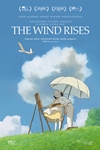 The Wind Rises
The Wind Rises
Featuring the voices of Joseph Gordon-Levitt, John Krasinski, Emily Blunt, Martin Short and Stanley Tucci
Directed by Hayao Miyazaki
From Studio Ghibli and Walt Disney Studios
Rated PG-13
126 minutes
Riding with the Wind
by Michael Clawson of Terminal Volume
If there was ever an animated film that was ready to burst out of its cells to inhabit our live-action world, as if by osmosis, then here it is: The Wind Rises, the supposed last film — “Eh, nevermind” — of Japanese cultural heavyweight Hayao Miyazaki.
Miyazaki is the creator of Spirited Away, Princess Mononoke, My Neighbor Totoro and many other films from Studio Ghibli, the Japanese Pixar. He’s 73 and the world recoiled when he said he was retiring, and then exhaled rapidly when he said retirement wasn’t really for him. Of course not. Imagination doesn’t store well; it needs to be released into the world.
In past films the Japanese director used whimsy and fantasy to construct his elaborate visions, but The Wind Rises has a streak of realism that runs through it that may stir boredom in younger viewers, though their eyes will often grow wide and still at some of the magnificent animation. The film opens on Jirô, a serious young boy who is lost in his own head. We meet him first in his dream, where fantastical airplanes, hulking zeppelins and squid-like missiles fill the sky in a symphony of aerodynamic movement. Jirô awakes and decides right then he wants to build airplanes.
Many years later, an older Jirô finds himself working for Mitsubishi, where he and a team of engineers are trying to create the next great Japanese fighter plane. The fruits of their labor will eventually go on to wreak havok throughout the Pacific — including at Pearl Harbor, where many Americans died — but The Wind Rises is uninterested in war because Jirô is uninterested in war. He only wants to create something that will soar brilliantly and effortlessly through the sky.
On his journey are a competitive friend, various engineering partners, an Italian inventor he shares dreams with, a bespectacled little man with eyes no bigger than dimes, and Nahoko, a woman whose love and health are somehow inversely proportionate within the plot. Nahoko and Jirô, the film’s tragic core, have shared a traumatic event together, the Kantō earthquake of 1923. The sequence is animated with terrifying realism: waves of earth rise and fall, buildings crumble into heaps, fires spread from one wood-and-paper city to another and, in a haunting visual, bits of glowing embers fill the skies where Jirô’s dream-planes once zoomed.
Aside from several dream sequences and the earthquake scenes, The Wind Rises mostly dotes on Jirô’s quest to aviation greatness. His first assignment is a wing strut; his design reinvents the part. Later there’s new building materials, recessed riveting, bigger planes, faster engines and more majestic lines. He eventually designs a plane with inverted gull-shaped wings, and then the Japanese Zero, the fighter syonymous with the Japanese air force during World War II.
One of the more unique aspects of the film are the sound effects — almost all of them are created using mouth noises, from engines sputtering to life to dirigibles idling through the clouds to the low-rumble of a tectonic plates grinding together. I couldn’t help but smile thinking of sound technicians spitting raspberries into microphones, blowing into empty jugs or contorting their mouths as they give life to steam engines and twirling propellors. And since we’re on the topic of sounds, I highly encourage you to see the movie in Japanese with English subtitles if at all possible. Joseph Gordon-Levitt does a fine job voicing Jirô, but Hideaki Anno’s voice is much richer, with a slightly muffled timbre — it’s worth hearing.
Mostly, though, The Wind Rises is simply gorgeous to behold. The imagery is just astounding in every way. The hand-drawn backgrounds, scenes filled with indivudually animated people, the bits of Japanese culture painted into the edges of frames, the panning shots of trains chugging forward and carts being pulled through busy markets … almost every frame of this movie is breathtaking. I was especially impressed by the small details: Jirô bowing to woman on the platform between traincars, oxen pulling a new plane prototype onto a runway, and a scene with Jirô’s new boss pointing at a hat stand and then a desk, “Hat goes here. Data goes here. Got it?”
The Wind Rises has two companion pieces. The first is Isao Takahata’s watershed anime Grave of the Fireflies, another film in which realistic horrors are visited upon delightful hand-drawn animation. Takahata and Miyazaki were colleagues at Studio Ghibli, and they both understood then that animation wasn’t confining their mature themes, it was liberating them. The other companion piece is Steven Spielberg’s vastly underrated Empire of the Sun, in which a young Christian Bale plays a resilient English lad whose eyes are drawn to the skies and to the Japanese Zeros that have conquered it. The character seemed unaware of “sides” in a war, as does Jirô, whose dreams are gauged by altimeter.
This is a stunningly beautiful movie, and deeply moving. It’s also a departure for Miyazaki, who had previously turned fantastical creatures and plots into modern fairy tales. This is more biopic, but it’s still overflowing with imagination and incredible imagery. It's a must-see.









